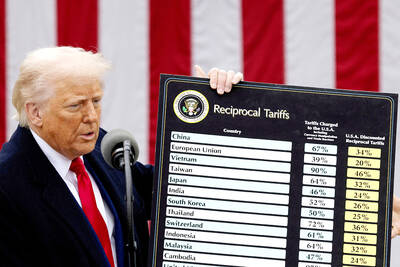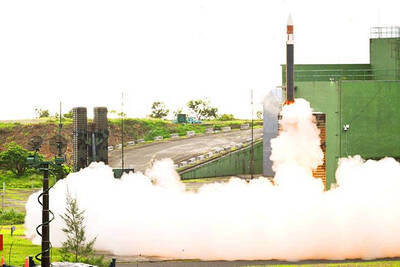If the number of elementary-school students in Taiwan drops by about 29,000 each year, the nation would have fewer than 1 million elementary-school students six years from now, the Ministry of Education said in a report.
The number of students at all levels of education are declining, with the number of elementary-school students dropping by about 29,000 per year, the ministry said in its 2024-2039 student number estimation report.
Aside from effects such as the Chinese zodiac on childbirth, the report showed that student numbers at elementary schools, junior-high schools, senior-high schools and universities are dropping.

Photo: Fang Pin-chao, Taipei Times
There are about 1.235 million elementary-school students, but that figure would decline to 955,000 in the 2029 school year and 779,000 in the 2039 school year, the report said.
There are about 546,000 junior-high students, but due to the increase in births in the Years of the Dragon and the 100th anniversary of the founding of the Republic of China (ROC) in 2011, the number would increase to about 622,000 in the 2026 school year, it said.
However, the number of junior-high students is expected to decline by about 8,900 each year after that, dropping to about 404,000 in the 2029 school year.
There are about 600,000 senior-high students, but the figure is expected to drop to 549,000 in the 2026 school year.
Also affected by the Years of the Dragon and the ROC 100th anniversary year, the number of senior-high students is expected to increase to about 625,000 in the 2029 school year, but would then continue to decline by about 12,000 people per year to 421,000 in the 2039 school year.
The number of university graduates is predicted to drop by 2,600 every year over the next 17 years, falling below 190,000 in the next school year, and to 155,000 in the 2031 school year, affected by the Year of the Tiger.
However, due to the Year of the Dragon, the number is expected to slightly increase to 177,000 in the 2033 school year, but drop to 161,000 in the 2039 school year.

WAITING GAME: The US has so far only offered a ‘best rate tariff,’ which officials assume is about 15 percent, the same as Japan, a person familiar with the matter said Taiwan and the US have completed “technical consultations” regarding tariffs and a finalized rate is expected to be released soon, Executive Yuan spokeswoman Michelle Lee (李慧芝) told a news conference yesterday, as a 90-day pause on US President Donald Trump’s “reciprocal” tariffs is set to expire today. The two countries have reached a “certain degree of consensus” on issues such as tariffs, nontariff trade barriers, trade facilitation, supply chain resilience and economic security, Lee said. They also discussed opportunities for cooperation, investment and procurement, she said. A joint statement is still being negotiated and would be released once the US government has made

Authorities have detained three former Taiwan Semiconductor Manufacturing Co (TMSC, 台積電) employees on suspicion of compromising classified technology used in making 2-nanometer chips, the Taiwan High Prosecutors’ Office said yesterday. Prosecutors are holding a former TSMC engineer surnamed Chen (陳) and two recently sacked TSMC engineers, including one person surnamed Wu (吳) in detention with restricted communication, following an investigation launched on July 25, a statement said. The announcement came a day after Nikkei Asia reported on the technology theft in an exclusive story, saying TSMC had fired two workers for contravening data rules on advanced chipmaking technology. Two-nanometer wafers are the most

NEW GEAR: On top of the new Tien Kung IV air defense missiles, the military is expected to place orders for a new combat vehicle next year for delivery in 2028 Mass production of Tien Kung IV (Sky Bow IV) missiles is expected to start next year, with plans to order 122 pods, the Ministry of National Defense’s (MND) latest list of regulated military material showed. The document said that the armed forces would obtain 46 pods of the air defense missiles next year and 76 pods the year after that. The Tien Kung IV is designed to intercept cruise missiles and ballistic missiles to an altitude of 70km, compared with the 60km maximum altitude achieved by the Missile Segment Enhancement variant of PAC-3 systems. A defense source said yesterday that the number of

Taiwanese exports to the US are to be subject to a 20 percent tariff starting on Thursday next week, according to an executive order signed by US President Donald Trump yesterday. The 20 percent levy was the same as the tariffs imposed on Vietnam, Sri Lanka and Bangladesh by Trump. It was higher than the tariffs imposed on Japan, South Korea and the EU (15 percent), as well as those on the Philippines (19 percent). A Taiwan official with knowledge of the matter said it is a "phased" tariff rate, and negotiations would continue. "Once negotiations conclude, Taiwan will obtain a better